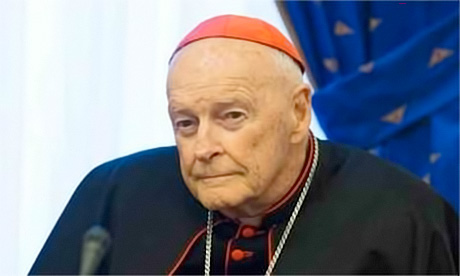Archbishop Theodore McCarrick, the former archbishop of Washington who last summer was removed from public ministry and who then resigned from the College of Cardinals, could also be dismissed from the clerical state, one of the highest forms of punishment issued to priests.
Also known as laicisation and sometimes referred to colloquially as defrocking, a sentence of laicisation would complete a stunning fall from grace for the former cardinal, who at one time wielded immense influence in both Rome and the United States.
Last year, then-Cardinal McCarrick was reported to the Archdiocese of New York, accused of abusing a 16-year-old boy in the 1970s.
Two more allegations of the abuse of minors also surfaced, as did claims that Archbishop McCarrick sexually harassed and assaulted priests and seminarians.
If the Vatican decides to expel Archbishop McCarrick from the priesthood, it would close one chapter of the abuse crisis, but many questions will remain.
What is laicisation?
The term “laicisation” refers to scenarios in which a member of the clergy, through the use of the church’s legal apparatus, is no longer permitted to act as a priest.
Sometimes a priest may petition Rome for laicisation, often in order to marry. (A priest who wishes to marry needs, in addition to laicisation, to request being released from his vow of celibacy, which is a separate process.)
In other cases, laicisation is a form of punishment, commonly described as being “dismissed from the clerical state,” often because of violations of the commandment barring adultery. (Before the 1983 revision to the code of canon law, priests who were laicised were often referred to as being “reduced” to the lay state.)
A sentence of laicisation would complete a stunning fall from grace for the former cardinal, who at one time wielded immense influence in both Rome and the United States.
This is the portion of canon law used by the church to prosecute priests and bishops accused of sexual abuse of a minor.
Between 2004 and 2014, the Vatican laicised 848 priestsbecause of sexual abuse.
Only the Vatican can laicise priests so accused, which critics say makes the process too cumbersome.
What does laicisation entail? Is it the same as defrocking?
When a priest is laicised, he is no longer permitted to celebrate the sacraments. He cannot preach a homily or hold a post at a seminary..
Nor is he allowed to present himself as a priest, meaning he cannot wear clerical garb.
This is where the slang term “defrocked” originates, referring to the taking away of a priest’s attire, though “defrocking” is not a technical term. (It is possible, however, that a priest could be ordered to refrain from wearing clericals in public without being dismissed from the clerical state.) Continue reading
- Image: Italian Insider
News category: Analysis and Comment.




